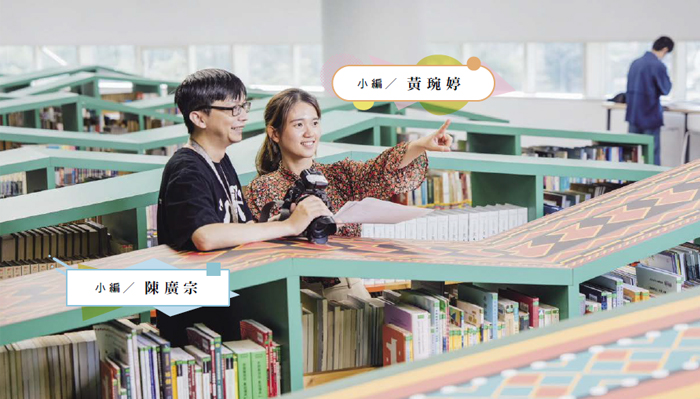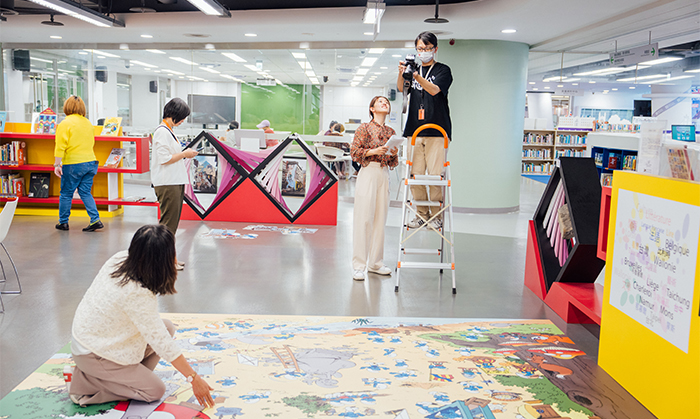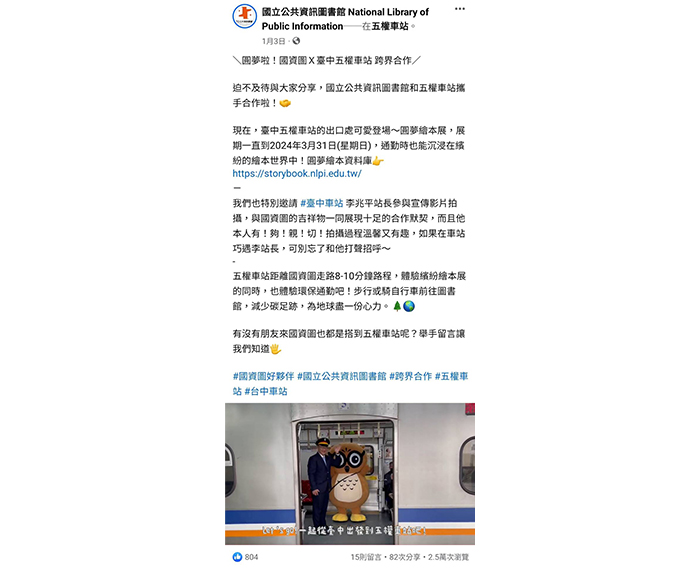To get closer to people of all ages, the National Library of Public Information also continues to operate a community, with library staff working part-time as community editors. It is expected that through the "Facebook" platform, through short texts, photos and short videos allow the public to get first-hand information even without entering the library. Through the transmission of the Internet, they can quickly understand the big and unimportant things in the library!

With the rise of self-media, social platforms are not only limited to simple sharing of private life, but also become another platform for all social classes and the public sector to communicate with the public. The position of community editor has also become a human bank in recent years popular job openings!
The Facebook (Face Book, FB) fan page of the National Library of Public Information (NLPI), it displays diverse services and activities in the museum in a diversified way. However, in these beautifully composed photos and relaxed and interesting behind the words, what are the community editors who are invisible behind the platform doing on daily basis?
Go with the flow and build adhesion

With so many library programs, it is important to ensure that all programs and information are effectively promoted to the community. As a senior editor of NLPI, Mr. Guang Zong Chen of the Reading Section said when he first took over the post, his job was much simpler than it is now, "Facebook was just emerging.
At that time, Facebook was just emerging, and to us, it was just another official bulletin board and mailbox.

Unlike in the past, today's social media platforms are an important medium for connecting libraries with their patrons, and information from all corners of the world spreads quickly through the community, making the community editor the "spokesperson of the community" for NLPI.
At that time, most of the museums of the same sex also used the social platform, however, with the increasing number of users, the social trend is emerging, and gradually become part of the public's daily life; at this time, Guang Zong Chen found that the application of the social platform is much broader and more diversified than imagined.
People who use social platforms don't just want you to tell them the time and place of an event, they also want to get some fun out of it," he says. With the change in the utilization of thinking, Guang Zong Chen no longer simply throws information onto the Internet, he began to think about how to further build up the adhesion of fans through the narration of text content, style changes and the help of other materials.
After years of exploration, he found that Internet readers often favor the presentation of a single photo over multiple images, motion pictures, videos, or plain text, and that a series of articles is more appealing than a single article. Guang Zong Chen also admits that the Internet ecosystem is changing rapidly, and users' habits are also shifting rapidly, "How to keep up with users' Internet habits is the biggest challenge for social editors.
Learning new skills and adding visibility to the platform
Change is the daily life of a community editor, and learning the eighteen martial arts outside of work is even more important. It is a "side business" that community editors must shoulder.
After realizing that photographs are far more attractive than words, Guang Zong Chen, who did not have a bachelor's degree in photography, began to take up photography as a sideline through continuous self-education and traveled to every NLPI event and exhibition. He traveled to every NLPI event and exhibition, thinking about the composition through the camera and finding people who wanted to be photographed on the spot.
For example, for the promotion of "Manitou Kono - Summer Youth Rally" to be held in 2023. Guang Zong Chen specially rented a set of Conan's costume and glasses props, invited a child who is reading in the museum as a graphic photography model, "In fact, he is the second we found, the first child because of the mood is not good, so has not been able to take the ideal picture.


Wan Ting Huang, another editorial writer from the Promotion Division, originally thought that the job of a social editor was to put pictures on social platforms and add a few paragraphs of text, "but after she became an editorial writer, she realized that an editorial writer needs to be able to produce pictures and also learn how to take beautiful pictures. Therefore, not being a design professional, she chose "Canva", which is easier to get started with, to produce graphic materials.
 The operation of social media is also a manifestation of information technology. Once she was given a sudden assignment to film the mascot riding from Taichung Station to Wu Quan Station. The assignment seemed simple, but she had never filmed before and had no scripts to assist her. "During the short trip, I had to think about the sequence of the movie, and when I arrived at the scene, I had to finish the shoot without fear of embarrassment.” Wan Ting Huang admits that community editors are often given "one-sentence instructions", such as "celebrate the 100th anniversary of the NLPI" or "organize a lucky draw", and then they must turn these simple words into a specific activity plan and share it with readers. "Being a community editor isn't as simple as being able to take photos and type, but also about being quick-witted, which assesses an editor's creativity and ability to execute."
The operation of social media is also a manifestation of information technology. Once she was given a sudden assignment to film the mascot riding from Taichung Station to Wu Quan Station. The assignment seemed simple, but she had never filmed before and had no scripts to assist her. "During the short trip, I had to think about the sequence of the movie, and when I arrived at the scene, I had to finish the shoot without fear of embarrassment.” Wan Ting Huang admits that community editors are often given "one-sentence instructions", such as "celebrate the 100th anniversary of the NLPI" or "organize a lucky draw", and then they must turn these simple words into a specific activity plan and share it with readers. "Being a community editor isn't as simple as being able to take photos and type, but also about being quick-witted, which assesses an editor's creativity and ability to execute."
With today's fast pace of life, the public prefers "short videos" that can absorb a large amount of information in a small amount of time, and NLPI has grasped the current trend by shooting various promotional themed short videos with the scripts, publicizing and promoting them in the pink specials, adjusting the updated postings of the activities launched by the library on a rolling basis, and using interesting and funny graphic designs, which not only allows the concerned readers to keep up with the latest news, but also allows the newly reached public to have a basic understanding of NLPI, and then to become the library's potential reader base.
Embracing children's hearts and creating brand affinity

The many challenges are just like breaking the barrier or fighting the Devil's King. Although community posts can attract many people to participate in the library's activities, community editors occasionally fall into the dilemma of being well received but not well received, which Guang Zong Chen called "ten thousand people responded, but one person showed up," implying that while the discussion on the community platform is heated, the participants at the actual activity site are few and far between.
"In the past, we used to be very concerned about the number of likes, but now we choose to let go." The algorithm of FB changes from time to time, and the reach is often inaccurate, "There are many social platforms nowadays, and the audience has been scattered.
For example, Guang Zong Chen began to study the back-end data and found that the highest reach rate of the public was found when articles were posted at 8 p.m. and 12 p.m. Wan Ting Huang, on the other hand, tracked down the social networking sites of other public departments to find the inspiration for her articles.
"Libraries are stereotypically boring and strict to the public, so it's the editor's job to increase our brand affinity with a light, humorous, and witty approach." Wan Ting Huang follows the fan pages of the National Museum of Natural Science, the Ministry of the Interior, and the Coast Guard, which also belong to the public sector, and her coworkers send her funny posts from time to time.

For example, the popular social media platform "Point about me that may surprise you" led Wan Ting Huang to write a very popular post, "Everyone's definition of a library is that it should be quiet and you can't eat, but the NLPI not only has a practice room, but you can also eat! This posting subsequently generated a great deal of response, and made Wan Ting Huang feel confident, "Letting the public know more about the State-owned Library is also the value of the editor's existence."
Although the daily life of an NLPI community editor is not easy, Wan Ting Huang and Guang Zong Chen always embrace a childlike spirit. As Wan Ting Huang said, "A community editor must be lively, outgoing, and childlike; after all, editors need to interact with readers, and if they keep their curiosity and open mind about things, they will be able to have a great time doing their job!
Turning ordinary words and abstract ideas into lively and interesting illustrations is the most important task of an editor, and how to gain a foothold in the jungle of social platforms is a goal that an editor needs to constantly learn and achieve.